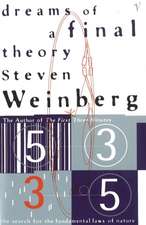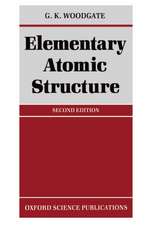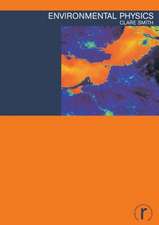Collisions of Electrons with Atoms and Molecules: Physics of Atoms and Molecules
Autor G.F. Drukareven Limba Engleză Paperback – 12 oct 2011
Din seria Physics of Atoms and Molecules
-
 Preț: 399.88 lei
Preț: 399.88 lei - 18%
 Preț: 1226.73 lei
Preț: 1226.73 lei - 18%
 Preț: 1268.07 lei
Preț: 1268.07 lei -
 Preț: 386.99 lei
Preț: 386.99 lei - 18%
 Preț: 959.98 lei
Preț: 959.98 lei - 15%
 Preț: 650.55 lei
Preț: 650.55 lei - 15%
 Preț: 651.02 lei
Preț: 651.02 lei - 18%
 Preț: 948.47 lei
Preț: 948.47 lei -
 Preț: 404.29 lei
Preț: 404.29 lei - 18%
 Preț: 954.77 lei
Preț: 954.77 lei - 15%
 Preț: 685.20 lei
Preț: 685.20 lei - 18%
 Preț: 1260.34 lei
Preț: 1260.34 lei - 5%
 Preț: 658.82 lei
Preț: 658.82 lei - 15%
 Preț: 661.14 lei
Preț: 661.14 lei - 18%
 Preț: 953.35 lei
Preț: 953.35 lei -
 Preț: 402.17 lei
Preț: 402.17 lei - 15%
 Preț: 645.47 lei
Preț: 645.47 lei - 18%
 Preț: 1222.49 lei
Preț: 1222.49 lei - 18%
 Preț: 959.67 lei
Preț: 959.67 lei - 18%
 Preț: 952.72 lei
Preț: 952.72 lei - 15%
 Preț: 664.43 lei
Preț: 664.43 lei - 18%
 Preț: 952.89 lei
Preț: 952.89 lei - 15%
 Preț: 662.16 lei
Preț: 662.16 lei -
 Preț: 392.75 lei
Preț: 392.75 lei - 20%
 Preț: 555.29 lei
Preț: 555.29 lei - 15%
 Preț: 638.57 lei
Preț: 638.57 lei - 15%
 Preț: 648.24 lei
Preț: 648.24 lei - 18%
 Preț: 1233.06 lei
Preț: 1233.06 lei - 18%
 Preț: 1233.83 lei
Preț: 1233.83 lei -
 Preț: 390.08 lei
Preț: 390.08 lei - 18%
 Preț: 957.44 lei
Preț: 957.44 lei - 18%
 Preț: 950.66 lei
Preț: 950.66 lei - 15%
 Preț: 603.70 lei
Preț: 603.70 lei - 15%
 Preț: 587.85 lei
Preț: 587.85 lei - 15%
 Preț: 643.65 lei
Preț: 643.65 lei - 18%
 Preț: 1230.84 lei
Preț: 1230.84 lei
Preț: 389.49 lei
Nou
Puncte Express: 584
Preț estimativ în valută:
74.53€ • 79.70$ • 62.14£
74.53€ • 79.70$ • 62.14£
Carte tipărită la comandă
Livrare economică 18 aprilie-02 mai
Preluare comenzi: 021 569.72.76
Specificații
ISBN-13: 9781461289975
ISBN-10: 1461289971
Pagini: 256
Ilustrații: 252 p.
Dimensiuni: 178 x 254 x 13 mm
Greutate: 0.45 kg
Ediția:Softcover reprint of the original 1st ed. 1987
Editura: Springer Us
Colecția Springer
Seria Physics of Atoms and Molecules
Locul publicării:New York, NY, United States
ISBN-10: 1461289971
Pagini: 256
Ilustrații: 252 p.
Dimensiuni: 178 x 254 x 13 mm
Greutate: 0.45 kg
Ediția:Softcover reprint of the original 1st ed. 1987
Editura: Springer Us
Colecția Springer
Seria Physics of Atoms and Molecules
Locul publicării:New York, NY, United States
Public țintă
ResearchCuprins
Introduction: General Description of Electron Collision Processes with Atomic Particles.- 0.1 The Concept of Cross Section.- 0.2 Interaction of Electrons with Atomsor Atomic Ions.- 0.3 Some Information about Atomic Structure.- 0.4 General Characteristics of the Cross SectionCalculation Methods.- 0.5 Collision Processes of Electrons with Moleculesand Molecular Ions.- Scattering of a Particle by a Potential.- 1.1 The Wave Function: Scattering Amplitude.- 1.2 Partial Waves Expansion.- 1.3 The Jost Function and its Properties.- 1.4 Scattering of a Slow Particle by a ShortRange Central Field: Resonances.- 1.5 Effect of a Long-range Tail in the Potentialwhich Falls as r-4.- 1.6 Effect of the Coulomb Attractive Potentialon Slow Particle Scattering.- 1.7 Scattering by Two Short-Range Nonoverlapping Potentials.- 1.8 Scattering by an Electric Dipole.- 1.9 Scattering of Fast Particles: Various Approximations.- Scattering of a Particle with Spin: Polarization Phenomena.- 2.1 Amplitude Matrix.- 2.2 The Density Matrix Formalism.- 2.3 Expressions for Observable Quantities.- 2.4 Polarization of a Beam of Particles.- 2.5 Scattering of a Partly-Polarized Beam.- The Simplest Two-Channel System.- 3.1 Formulation of the Problem: Boundary Conditions: S-matrix.- 3.2 Elastic Scattering Below the Threshold:Resonances.- 3.3 Cusps.- 3.4 Cross Sections Above the Threshold.- 3.5 Effect of an Attractive Coulomb Field.- Collisions of Electrons with Atoms and Ions: General Theory.- 4.1 Wave Function of the System: Amplitudes andCross Sections.- 4.2 The Total Spin Representation: Separation ofthe Spin Variables.- 4.3 Reduction of the Many-Channel Problem.- 4.4 Partial Waves: The Total Angular MomentumRepresentation.- 4.5 The Jost Matrix and Related Matrices.- 4.6 Effects of Closed Channels.- 4.7 Correlation and Polarization Phenomena.- Approximate Methods for Electron-Atom Collisions: Cross Section Calculations.- 5.1 Methods for the Approximate Solution of theMany-Channel Problem.- 5.2 The Born Approximation and its Modifications.- 5.3 The Glauber Approximation.- 5.4 Classical Mechanics (Binary Approximation).- Elastic and Inelastic Scattering of Electrons by Atoms and Positive Ions.- 6.1 Hydrogen.- 6.2 Helium.- 6.3 Alkali Metal Atoms (Li, Na, K, Cs).- 6.4 Other Atoms: References and Comments.- 6.5 Collisions of Electrons with Positive Ions.- Ionization.- 7.1 Threshold Behavior of the IonizationCross Section.- 7.2 The Differential Cross Sections: General Relations.- 7.3 Ionization Through Excitation of AutoionizingStates: Postcollision Interaction.- 7.4 Hydrogen.- 7.5 Helium.- 7.6 Total Ionization Cross Sections for Various Atoms.- Rotational and Vibrational Excitation of Molecules.- 8.1 Excitation of Rotation of Two Atom Molecules Below the Vibrational Threshold.- 8.2 Excitation of Vibrations and Combined Rotational-Vibrational Transitions.- Dissociation of Molecules.- 9.1 Dissociative Attachment.- 9.2 Dissociative Recombination.- 9.3 Dissociation Through Electronic Excitation.- References.
















